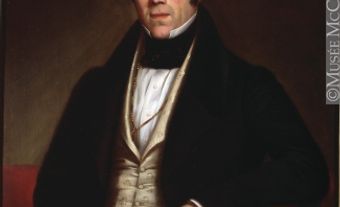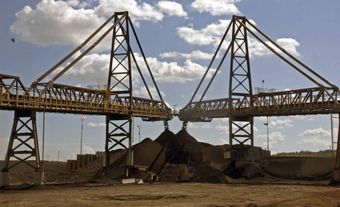Redpath Sugar Ltd. is a Canadian sugar refining company (see Sugar Industry). It is one of the oldest continuously operated companies in Canada. It is also the oldest sugar cane refining operation in Canada, having been established in Montreal in 1854. The company bears the name of its founder, John Redpath, whose company expanded considerably under the direction and leadership of his son, Peter Redpath, and his son-in-law, Sir George Alexander Drummond. In 2007, Redpath Sugar Ltd. became a subsidiary of American Sugar Refining (ASR Group). Redpath Sugar Ltd.’s primary production and refining operation is located on the Toronto waterfront.

Sugar Industry in Canada
Sugar is a basic and fundamental ingredient in cooking and baking, common to cuisines found all over the world. (See also Baking Industry; Confectionery Industry.) Raw sugar cane, an easily exploitable source of sugar, is found primarily in tropical areas, such as the Caribbean. Growing European demand for sugar motivated the development and expansion of sugar plantations in the Caribbean from the 16th and 18th centuries. Because harvesting sugar cane is a labour-intensive process, European colonizers used enslaved people (either the Indigenous people of the Caribbean or enslaved Africans) as the labour force. (See also Black Enslavement in Canada; Enslavement of Indigenous People in Canada.) Sugar, along with cotton, was a resource almost exclusively cultivated by enslaved peoples during this era. Both resources also formed part of the foundation of the mercantilist economies developed by European colonizers during this era (see Mercantilism).
Refining raw sugar cane into the consumable sugar we use to cook and bake with requires the construction of specialized industrial buildings called “sugar refineries” and these can be expensive to build. The success of the abolitionist movement in the British Empire during the 19th century had a profound effect on the global sugar industry, and in part led to the development of a local sugar beet industry in Canada. It also became more advantageous to ship raw sugar cane to refineries in Canada, rather than shipping refined sugar. In early 19th-century British North America, refined sugar was either obtained from Great Britain at inflated prices or was procured from the United States. The War of 1812 disrupted this economic arrangement and provided further support for proponents who wanted to refine sugar locally in Canada.
The first sugar refinery in Halifax, Nova Scotia was established in 1818. Early proponents of local sugar refining argued that refining sugar locally could produce a superior product that was also cheaper for consumers. Early attempts to develop the sugar industry in British North America focused on Halifax, a natural deepwater port on the Atlantic Ocean. Though these efforts ultimately weren’t successful, sugar refining operations succeeded in Montreal, with the first refinery opening in 1854. Montreal succeeded as an initial centre for sugar refining because it had year-round port access. In addition, there was access to regional (and later, intercontinental) railways, as well as the Lachine Canal and the lock system on the St. Lawrence and Ottawa rivers. These advantages in terms of infrastructure, coupled with Montreal’s large population, made sugar refining profitable.
As Canada grew and expanded, new refineries were built to adequately supply Canadians with refined sugar. In 1890, a refinery was opened in Vancouver that could import sugar cane from Asia and refine it for Canadian consumers in the Western provinces. As the population of the Prairie provinces grew in the late 19th and early 20th centuries, the production and refining of sugar beets became profitable. (See also History of Settlement in the Canadian Prairies.) Similarly, as the population of Atlantic Canada grew, a new sugar cane refinery was built in Saint John, New Brunswick. (See also Sugar Industry.)
Redpath Sugar Refinery
Redpath Sugar is named for its founder, John Redpath, who emigrated to Lower Canada in 1816. Redpath steadily acquired lots of land along the Lachine Canal to make space for his next major investment — the Province of Canada's largest, first and foremost industrial sugar refinery. Construction of the refinery began in 1854 and the facility was operational within a year. Redpath is estimated to have invested £40,000 into buying the land, erecting the refinery and outfitting it with machinery. Redpath also provided the same amount in capital to start operations. Originally named the Canada Sugar Refining Company, Redpath’s operation employed about 100 men and was producing an estimated 3,000 barrels of refined sugar per month for the domestic market by 1855.

The refinery quickly established itself and further helped establish the Lachine Canal industrial harbour as the beating heart of Canadian industry. The refinery was wholly dependent on imports of raw sugar cane from the Caribbean, most of which was imported on Redpath’s ships, the Helen Drummond and Grace Redpath. These ships could transport raw sugar cane straight to the refinery and unload their cargo directly. Railways allowed finished sugar to be shipped out just as directly, avoiding the need for transshipment which could increase overall costs. (See also Railway History in Canada.)
As the business succeeded, John Redpath stepped away from the day-to-day operations of the refinery. His son, Peter Redpath, and son-in-law, George A. Drummond, took greater control. By 1861, both Peter and George were partners. Under Drummond’s direction, a new six-storey addition to the original refinery doubled its capacity in the 1860s. By 1862, the company was annually importing about 7,000 tons of raw sugar to the Montreal refinery. Coincidentally, favourable tariffs enacted by the Canadian government in 1855 — the year the Redpath refinery became fully operational — allowed for the Redpath company to succeed without having to compete with American sugar refineries.

Protectionism
The initial success of John Redpath and Son (as the firm was originally known) may have been partly due to the protectionist trade policies of the Province of Canada and then the early Confederation government of John A. Macdonald. These policies were eliminated in the mid-1870s by the government of Alexander Mackenzie, which favoured free trade with the United States. The decision proved to be nearly disastrous for the Redpath refinery, as free trade allowed inexpensive sugar from the United States to enter the Canadian market. The consequence of this change in policy resulted in the decision to close the refinery and lay off its 300 employees in 1876. The closure was to be short-lived, however, as in 1878, John A. Macdonald was re-elected on a platform largely driven by economic protectionism, the National Policy.
The National Policy sought to protect Canadian enterprises from competition with their larger American counterparts (a move that was thought to be necessary to allow for the development of an independent Canadian economy). Though the National Policy was popular, it was also criticized, as it would give a handful of already wealthy Canadian entrepreneurs near total monopolies in their respective areas of business. Peter Redpath was specifically singled out as a likely benefactor from the policy. In order to appease critics, George A. Drummond decided to reorganize the company, incorporating it as a joint-stock company. (See also Stock and Bond Markets.) The new firm was established in 1879 and was called the Canada Sugar Refining Company, Limited. Drummond appointed himself president.
Recent History
In 1930, the company merged with the Dominion Sugar Company, Limited, of Chatham, Ontario. Following the merger, the company was renamed the Canada and Dominion Sugar Company Limited. Following the completion of the St. Lawrence Seaway in 1959, the firm opened a new refinery in the Toronto Harbour. The company changed its name to Redpath Sugar Ltd. in 1959, the same year it opened its Toronto refinery. The Toronto refinery has served as the Redpath Sugar Ltd.’s primary sugar refinery since the closure of the original Montreal refinery in 1980. The Montreal refinery has been preserved as loft condominiums. The company was renamed Redpath Industries Limited in 1973. The company has been a subsidiary of American Sugar Refining since 2007.
Did you know?
Queen Elizabeth II opened Redpath Sugar Ltd.’s Toronto refinery in 1959. She and Prince Philip also toured the newly opened refinery. (See also Toronto Feature: Redpath Sugar Refinery.)

Redpath Sugar Refinery Museum
The Redpath Sugar Refinery in Toronto features a small museum located at the back of the refinery. The museum includes exhibits about the history of the sugar industry in Canada, the Redpath family and the process of refining raw sugar.

 Share on Facebook
Share on Facebook Share on X
Share on X Share by Email
Share by Email Share on Google Classroom
Share on Google Classroom



_IMO_9785756,_Maasmond_pic.jpg)
